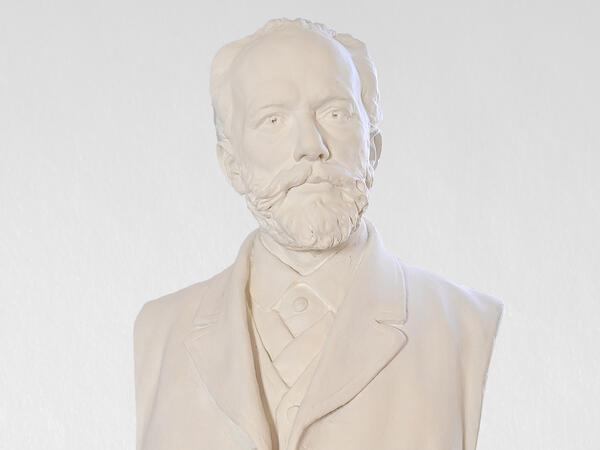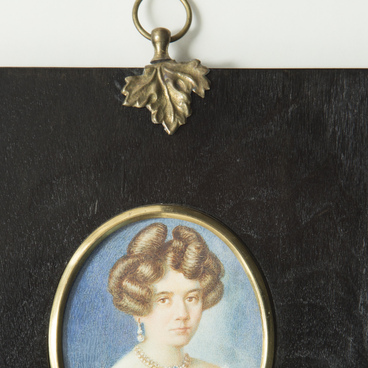The museum displays a sculptural portrait of Pyotr Tchaikovsky, created by sculptor and professor, academician of the St. Petersburg Academy of Arts, Robert Bach.
An entire artistic dynasty of Bachs — ‘the Russian Germans’ — lived in St. Petersburg. Robert Bach was the third son in the family. He was born on January 28, 1859, entered a prestigious Lutheran school, known as Annenschule, at the St. Anne’s Church in St. Petersburg. Over the years, Nicholas Miklouho-Maclay, Vasily Struve, Carl Fabergé, and others studied there. However, Robert Bach was not on the list of alumni. As it is noted in the school chronicles, that he dropped out “in the period between Easter of 1878 and Easter of 1879 to enter the Academy of Arts.”
Bach successfully passed the exam in drawing and artistic modeling, and became a non-matriculated student of sculpture classes for a fee of 25 rubles a year. In addition to his studies at the Academy, the young sculptor attended the home school of academician of painting Pavel Chistyakov. Along with Bach, artists Mikhail Vrubel and Valentin Serov studied there.
Robert Bach’s creative interests included monumental and easel sculpture, small plastic arts and applied arts. For 15 years, he collaborated with the Kasli Iron Casting Plant. The enterprise used his models to cast portraits of Russian cultural figures and animalistic works.
Bach created an entire gallery of portraits of emperors, artists, writers, and composers. Among his famous works are monuments to Emperor Alexander III in Feodosia, sculptures of Russian poet Alexander Pushkin depicted as a lyceum student in Tsarskoe Selo, and of Mikhail Glinka in St. Petersburg. The sculptor created portraits of Fyodor Dostoevsky, Ivan Krylov, Ivan Turgenev, and later Pyotr Tchaikovsky.
He perfectly mastered the technique of modeling and tried to move away from the strict dogmas of academic art; in particular, he attempted to convey characteristic features and psychological state of his sitters.
He portrayed Tchaikovsky with his hair smoothly combed back, a neatly trimmed mustache, and a small beard. The composer is dressed in a buttoned-up shirt, a waistcoat, and an unbuttoned frockcoat. The bust is mounted on a rectangular decorated stand.
An entire artistic dynasty of Bachs — ‘the Russian Germans’ — lived in St. Petersburg. Robert Bach was the third son in the family. He was born on January 28, 1859, entered a prestigious Lutheran school, known as Annenschule, at the St. Anne’s Church in St. Petersburg. Over the years, Nicholas Miklouho-Maclay, Vasily Struve, Carl Fabergé, and others studied there. However, Robert Bach was not on the list of alumni. As it is noted in the school chronicles, that he dropped out “in the period between Easter of 1878 and Easter of 1879 to enter the Academy of Arts.”
Bach successfully passed the exam in drawing and artistic modeling, and became a non-matriculated student of sculpture classes for a fee of 25 rubles a year. In addition to his studies at the Academy, the young sculptor attended the home school of academician of painting Pavel Chistyakov. Along with Bach, artists Mikhail Vrubel and Valentin Serov studied there.
Robert Bach’s creative interests included monumental and easel sculpture, small plastic arts and applied arts. For 15 years, he collaborated with the Kasli Iron Casting Plant. The enterprise used his models to cast portraits of Russian cultural figures and animalistic works.
Bach created an entire gallery of portraits of emperors, artists, writers, and composers. Among his famous works are monuments to Emperor Alexander III in Feodosia, sculptures of Russian poet Alexander Pushkin depicted as a lyceum student in Tsarskoe Selo, and of Mikhail Glinka in St. Petersburg. The sculptor created portraits of Fyodor Dostoevsky, Ivan Krylov, Ivan Turgenev, and later Pyotr Tchaikovsky.
He perfectly mastered the technique of modeling and tried to move away from the strict dogmas of academic art; in particular, he attempted to convey characteristic features and psychological state of his sitters.
He portrayed Tchaikovsky with his hair smoothly combed back, a neatly trimmed mustache, and a small beard. The composer is dressed in a buttoned-up shirt, a waistcoat, and an unbuttoned frockcoat. The bust is mounted on a rectangular decorated stand.



